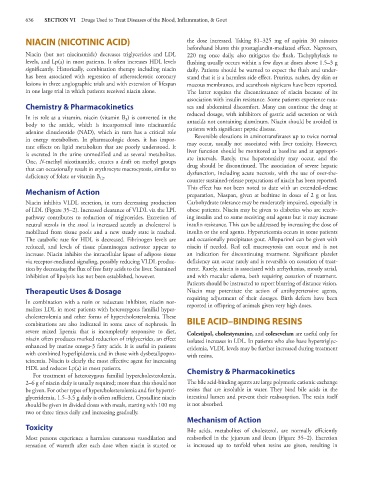Page 650 - Basic _ Clinical Pharmacology ( PDFDrive )
P. 650
636 SECTION VI Drugs Used to Treat Diseases of the Blood, Inflammation, & Gout
NIACIN (NICOTINIC ACID) the dose increased. Taking 81–325 mg of aspirin 30 minutes
beforehand blunts this prostaglandin-mediated effect. Naproxen,
Niacin (but not niacinamide) decreases triglycerides and LDL 220 mg once daily, also mitigates the flush. Tachyphylaxis to
levels, and Lp(a) in most patients. It often increases HDL levels flushing usually occurs within a few days at doses above 1.5–3 g
significantly. Historically, combination therapy including niacin daily. Patients should be warned to expect the flush and under-
has been associated with regression of atherosclerotic coronary stand that it is a harmless side effect. Pruritus, rashes, dry skin or
lesions in three angiographic trials and with extension of lifespan mucous membranes, and acanthosis nigricans have been reported.
in one large trial in which patients received niacin alone. The latter requires the discontinuance of niacin because of its
association with insulin resistance. Some patients experience nau-
Chemistry & Pharmacokinetics sea and abdominal discomfort. Many can continue the drug at
reduced dosage, with inhibitors of gastric acid secretion or with
In its role as a vitamin, niacin (vitamin B ) is converted in the antacids not containing aluminum. Niacin should be avoided in
3
body to the amide, which is incorporated into niacinamide patients with significant peptic disease.
adenine dinucleotide (NAD), which in turn has a critical role Reversible elevations in aminotransferases up to twice normal
in energy metabolism. In pharmacologic doses, it has impor- may occur, usually not associated with liver toxicity. However,
tant effects on lipid metabolism that are poorly understood. It liver function should be monitored at baseline and at appropri-
is excreted in the urine unmodified and as several metabolites. ate intervals. Rarely, true hepatotoxicity may occur, and the
One, N-methyl nicotinamide, creates a draft on methyl groups drug should be discontinued. The association of severe hepatic
that can occasionally result in erythrocyte macrocytosis, similar to dysfunction, including acute necrosis, with the use of over-the-
deficiency of folate or vitamin B . counter sustained-release preparations of niacin has been reported.
12
This effect has not been noted to date with an extended-release
Mechanism of Action preparation, Niaspan, given at bedtime in doses of 2 g or less.
Niacin inhibits VLDL secretion, in turn decreasing production Carbohydrate tolerance may be moderately impaired, especially in
of LDL (Figure 35–2). Increased clearance of VLDL via the LPL obese patients. Niacin may be given to diabetics who are receiv-
pathway contributes to reduction of triglycerides. Excretion of ing insulin and to some receiving oral agents but it may increase
neutral sterols in the stool is increased acutely as cholesterol is insulin resistance. This can be addressed by increasing the dose of
mobilized from tissue pools and a new steady state is reached. insulin or the oral agents. Hyperuricemia occurs in some patients
The catabolic rate for HDL is decreased. Fibrinogen levels are and occasionally precipitates gout. Allopurinol can be given with
reduced, and levels of tissue plasminogen activator appear to niacin if needed. Red cell macrocytosis can occur and is not
increase. Niacin inhibits the intracellular lipase of adipose tissue an indication for discontinuing treatment. Significant platelet
via receptor-mediated signaling, possibly reducing VLDL produc- deficiency can occur rarely and is reversible on cessation of treat-
tion by decreasing the flux of free fatty acids to the liver. Sustained ment. Rarely, niacin is associated with arrhythmias, mostly atrial,
inhibition of lipolysis has not been established, however. and with macular edema, both requiring cessation of treatment.
Patients should be instructed to report blurring of distance vision.
Therapeutic Uses & Dosage Niacin may potentiate the action of antihypertensive agents,
requiring adjustment of their dosages. Birth defects have been
In combination with a resin or reductase inhibitor, niacin nor- reported in offspring of animals given very high doses.
malizes LDL in most patients with heterozygous familial hyper-
cholesterolemia and other forms of hypercholesterolemia. These
combinations are also indicated in some cases of nephrosis. In BILE ACID–BINDING RESINS
severe mixed lipemia that is incompletely responsive to diet, Colestipol, cholestyramine, and colesevelam are useful only for
niacin often produces marked reduction of triglycerides, an effect isolated increases in LDL. In patients who also have hypertriglyc-
enhanced by marine omega-3 fatty acids. It is useful in patients eridemia, VLDL levels may be further increased during treatment
with combined hyperlipidemia and in those with dysbetalipopro- with resins.
teinemia. Niacin is clearly the most effective agent for increasing
HDL and reduces Lp(a) in most patients. Chemistry & Pharmacokinetics
For treatment of heterozygous familial hypercholesterolemia,
2–6 g of niacin daily is usually required; more than this should not The bile acid-binding agents are large polymeric cationic exchange
be given. For other types of hypercholesterolemia and for hypertri- resins that are insoluble in water. They bind bile acids in the
glyceridemia, 1.5–3.5 g daily is often sufficient. Crystalline niacin intestinal lumen and prevent their reabsorption. The resin itself
should be given in divided doses with meals, starting with 100 mg is not absorbed.
two or three times daily and increasing gradually.
Mechanism of Action
Toxicity Bile acids, metabolites of cholesterol, are normally efficiently
Most persons experience a harmless cutaneous vasodilation and reabsorbed in the jejunum and ileum (Figure 35–2). Excretion
sensation of warmth after each dose when niacin is started or is increased up to tenfold when resins are given, resulting in

